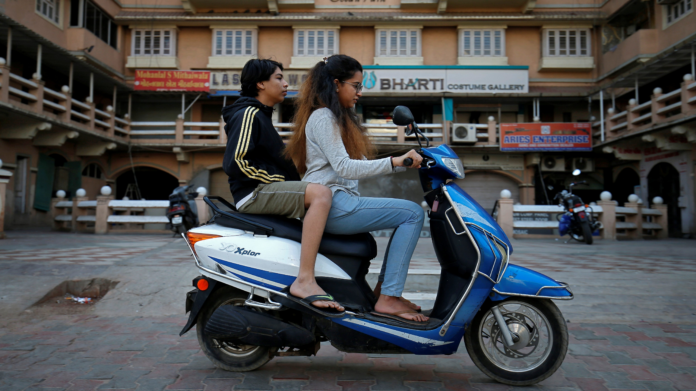Indian transportation unicorn Ola has managed to garner massive interest in its newly launched electric scooter range, but the company’s true litmus test is still a few months away.
On Aug. 15, when Ola launched its electric scooter, it was quickly touted as the frontrunner. With an impressive 100,000 units pre-booked, a palatable Rs1.3 lakh ($1,750) price tag—even lesser with subsidies in some states—and competition only from smaller niche players like Ather Energy, Ola looks well poised to win the market.
But the company may not be able to enjoy this limelight forever.
By the start of next year, Hero MotoCorp—the world’s largest two-wheeler manufacturer for the last 20 years—is set to debut its electric two-wheeler model. The incumbent will not only rely on fixed charging but also use battery swapping tech, courtesy of its partnership with renowned Taiwanese EV manufacturer Gogoro.
Facebook/Hero MotoCorp Hero MotoCorp electric scooter teaser.
“Given the entire appetite and the infrastructure that exists, it is complementary that our own programme works on fixed charging and then with Gogoro which will work on swapping, that allows us to play in both the spaces,” Hero MotoCorp chief financial officer Niranjan Gupta had said during an analyst call earlier this year.
Experts say Hero is the Goliath that Ola must be wary of.
Hero MotoCorp’s two-wheeler legacy
Founded in 1984, Hero MotoCorp (formerly Hero Honda) now has six plants across India with a total annual production capacity of 11.6 million units.
The massive scale will help Hero MotoCorp keep costs down and price their products competitively, experts say.
Rival Ola is in the process of setting up its “Future Factory” in Tamil Nadu, which will have a production capacity of 10 million when it’s completed.
“Electric vehicles have a low operating cost and that’s something a lot of people know but they also know that these vehicles have a very high upfront cost. So bringing down the upfront cost using some innovative financial model can be the game-changer for the industry,” Amit Bhatt, director of Integrated Urban Transport at environmental think tank World Resources Institute India, told Quartz.
Moreover, staying afloat while building the business will come easy to Hero MotoCorp. The company clocked revenues of Rs5,487 crore for April-June, up 85% from the year prior, when Covid lockdowns had put a damper on auto sales in India. It had a profit of Rs365 crore during the quarter, marking a 496% year-over-year rise. As of March 31, the company had a cash reserve of Rs 169.22 crore. It also has over 6,000 dealerships, giving it a large existing customer base to start off with.
In comparison, Ola has been loss-making since its inception in December 2010. In fiscal year 2019, Ola posted a loss of over Rs2,500 crore.
“We all know EV category will not be profitable from Day 1 and it will require a lot of cash. Hero will be placed in a better situation simply because of the size of the procurement, manufacturing, and distribution which a new player will have to replicate,” Hero MotoCorp’s Gupta told Business Standard.
Hero’s chairman, managing director, and CEO Pawan Munjal has called the company’s scooter a “bolt of lightning,” suggesting it’ll match or outrun its competitors in terms of speed.
However, the brand will face one hiccup: Hero MotoCorp can’t use the “Hero” brand for its EVs.
Hero MotoCorp vs Hero Electric
Hero MotoCorp is in conflict with the separate EV company Hero Electric, which is run by Munjal’s cousin Vijay Munjal’s son, Naveen Munjal. A 2010 family agreement bars Hero MotoCorp from using the term ‘Hero Electric’ for its products.
Hero Electric leads the high-speed electric scooter market with a 37% share.
“Hero Electric is in the business for a while and presently tops the sales chart. Along with the first-mover advantage the company has strong brand equity, deep-rooted distribution network, and wide product portfolio,” said Bakar Sadik Agwan, Senior Automotive Analyst at GlobalData. “The company has been quite dynamic in customer acquisition—it offers vehicle subscription, has exchange offers on used petrol two-wheelers, offers extended warranties and other attractive price promotions. It has partnered with several companies for B2B sales of its EVs.”
But that doesn’t mean Hero MotoCorp can’t be a formidable rival for Ola. Especially since its own brand isn’t its only play in the market.
Ather Energy versus Ola
Hero MotoCorp has been investing in Ather Energy since 2016 and now owns a 35% stake in the Bengaluru-based electric scooter startup.
The eight-year-old startup has been developing new products and ramping up production. Government subsidies have helped boost its sales. And more players launching their vehicles has aided Ather’s business.
“In the last six months, 10x more customers have become aware of EV scooters due to Ola’s launch,” Tarun Mehta, founder and CEO of Ather Energy, told MoneyControl. “The biggest impact for us is that we do not have to focus our marketing spends on awareness anymore.” Chetak’s launch in Pune led to higher Ather sales, too.
Ather expects to turn profitable by next year. It is currently available in 27 cities and is aiming to launch in 13 more by the end of this year.
Despite the big dreams, the road ahead—for Ola, Hero MotoCorp, Ather, and others—is still bumpy.
“The product (electric scooter) still has a challenge in terms of equating with the performance and efficiency of bio fuel-based counterparts,” said Faisal Kawoosa, founder and chief analyst at techARC. “Also, issues like a network of charging stations also inhibit growth. We also face monsoon for the entire country and will have to see how they don’t get completely damaged in rainy seasons especially due to waterlogging on roads.”
Hero MotoCorp and Ather Energy to rival Ola’s electric scooter
RELATED ARTICLES




